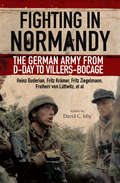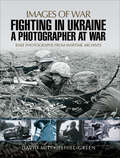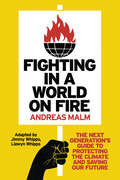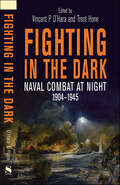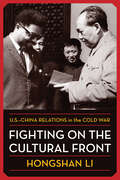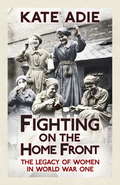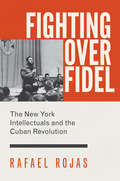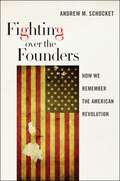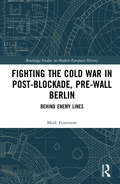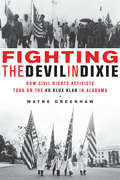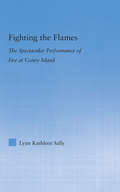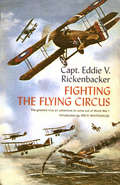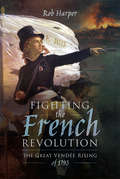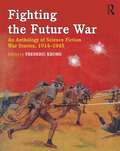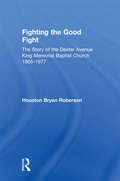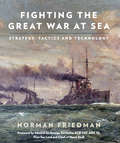- Table View
- List View
Fighting in Normandy: The German Army from D-Day to Villers-Bocage
by David C. IsbyCollected in-depth accounts from Nazi commanders chronicling their efforts to fight back against the Allied invasion at Normandy during World War II. The Allied landings on the Normandy beaches in June 1944 were brilliantly executed but proved to be just the opening phase of a desperately fought battle. The German Army responded to the invasion with as much ferocity and force as it could muster, and turned the struggle into a brutal and prolonged campaign. These in-depth reports by German commanders given the task of turning the tables on the invaders is crucial to a full understanding of the battle for Normandy. The accounts David Isby has selected, all written soon after the war&’s close for American military intelligence, cover German attempts to stem the invasion, dramatic defensive battles in the Norman countryside and attempts to implement a series of counterattacks. This vital source material presents the German perspective on the fighting, from regimental to corps level, and graphically illustrates the wealth of problems faced by an army on the very brink of destruction.
Fighting in Ukraine: A Photographer at War (Images of War)
by David Mitchelhill-GreenThis WWII pictorial history shares the personal images captured by a German photographer and soldier who fought on the Eastern Front. The outcome of the Second World War was decided on the Eastern Front. Denied a swift victory over Stalin&’s Red Army, Hitler&’s Wehrmacht found itself in a bloody, protracted struggle that it was ill-prepared to fight. Fighting in the Ukraine captures the drama and struggle of the Eastern Front through the extraordinary personal record of a professional photographer, Walter Grimm, who served in the German Army in a communications unit. David Mitchelhill-Green brings Grimm&’s previously unpublished photographs together with a highly informative introduction. The 300 evocative black and white images provide an absorbing insight into the daily life and privations of the ordinary German soldier amid the maelstrom of history&’s largest conflict. The Ukrainian people, many of whom initially welcomed the Germans as liberators, freeing them from Bolshevik oppression, are also chronicled in this fascinating photographic study.
Fighting in a World on Fire: The Next Generation's Guide to Protecting the Climate and Saving Our Future
by Andreas MalmAn argument for bold action to halt climate destruction, adapted for young people from Andreas Malm&’s best-selling bookYoung people are inheriting a world of climate catastrophe. Young people are also one of the strongest forces leading movements for climate justice, and to halt the fossil fuel emissions that are making our Earth unlivable. As Greta Thunberg and the Fridays for the Future movement have made clear, solutions offered by adults are far too little, far too late: the measures in unenforceable international agreements won&’t halt our reliance on fossil fuels, or take the drastic steps humans need to take in order to keep our planet livable.What kinds of drastic steps are needed? What kind of bold actions can the climate justice movement begin using to bring a stop to climate destruction, and that can be employed alongside existing strategies of mass protest, awareness, and legal appeals? Why does our society consider profit for oil companies more important than the future of young people and the health of our shared environment?In this adaptation of Andreas Malm&’s best-selling book on the need for a bolder, more confrontational climate justice movement, these urgent questions are brought to the most important audience of all: those who are growing up in a world on fire.
Fighting in the Dark: Naval Combat at Night, 1904–1945
by Vincent O’Hara and Trent HoneFighting in the Dark is a new book about naval combat at night; the title also, however, signifies the overarching theme of the book, of moving from dark to light: in short, the process of mastering technological change during war. The authors start with the proposition that it is hard to hit an invisible target, particularly one in motion. In the nineteenth century, when ships relied upon visual signaling and vessels beyond hailing range were deaf and mute in the dark, night battles at sea were rare and largely accidental. Three inventions changed this: the torpedo, the searchlight, and the radio. These inventions at the end of the nineteenth and start of the twentieth centuries transformed naval warfare by making combat in the dark feasible and in some cases, desirable. The process by which navies used the dark and adapted it into a medium for effective combat was long and difficult, more so for some than others. This book is about that process and about how Russian, British, German, Italian, Japanese and US navies confronted the specific new challenges and adapted to unfamiliar situations and emerging technologies. Fighting in the Dark consists of chapters written by a group of highly respected naval historians, and the book’s approach illuminates how different navies and cultures approached common problems. The fierce night-time battles that are described serve as a metaphor for the larger issues and the reader is led along a fascinating journey of naval warfare from the Russo-Japanese War, through WWI, to the Second World War, and from the Pacific to the English Channel.
Fighting in the Shadows: Untold Stories of Deaf People in the Civil War
by Harry G. LangThis visually rich volume presents Harry G. Lang’s groundbreaking study of deaf people’s experiences in the Civil War. Based on meticulous archival research, Fighting in the Shadows reveals the stories of both ordinary and extraordinary deaf soldiers and civilians who lived through this transformative period in American history. Lang documents the participation of deaf soldiers in the war, whose personal tests of fortitude and perseverance have not been previously explored. There were also many deaf people in noncombat roles whose stories have not yet been told—clerks and cooks, nurses and spies, tradespeople supporting the armies, farmers supplying food to soldiers, and landowners who assisted (or resisted) troops during battles. Deaf writers, diarists, and artists documented the war. Even deaf children contributed actively to the war efforts. Lang pieces together hundreds of stories, accompanied by numerous historical images, to reveal a powerful new perspective on the Civil War. These soldiers and civilians were not “disabled” by their deafness. On the contrary, despite the marginalization and paternalism they experienced in society, they were able to apply their skills and knowledge to support the causes in which they ardently believed. Fighting in the Shadows is a story of how deaf civilians and soldiers put aside personal concerns about deafness, in spite of the discrimination they faced daily, in order to pursue a cause larger than themselves. Yet their stories have remained in the shadows, leaving most Americans, hearing and deaf, largely unaware of the deaf people who made significant contributions to the events that changed the course of our nation’s history. This book provides new insights into Deaf history as well as into mainstream interpretations of the Civil War.
Fighting in the Sky: The Story in Art
by John Fairley&“The thoughtful text and assortment of paintings illustrate just over a century of military aviation, from those early biplanes . . . to modern drones.&” —Military Model Scene Barely a decade passed from the Wright Brothers&’ first powered flight to aircraft becoming lethal instruments of war. The Royal Flying Corps and Royal Naval Air Service took off in the very early days of The Great War and captured the public&’s imagination and admiration. Sydney and Richard Carline happened to be both pilots and artists as was Frenchman Henri Farre. Their works inspired celebrated painters like Sir John Lavery who took to the skies in an airship in the First World War. Feeding on the demand for works depicting this new dimension of warfighting, a new genre of art was born which has remained popular ever since. During the Second World War, the paintings of Paul Nash stood out as did Eric Ravilious who, ironically, died in an air crash. War artist Albert Richards dropped with British paratroopers on D-Day. Post-war, paintings by leading British and international artists graphically illustrate conflicts such as the Falklands, Bosnia and the Gulf War. John Fairley has brought together a dazzling collection of art works covering over 100 years of air warfare, enhanced by lively and informative text. The result is a book that is visually and historically satisfying.&“This book is highly recommended based upon the outstanding prose, spectacular artwork, and coverage of the histories of the conflicts covered.&” —IPMS/USA&“Taken together, the paintings and descriptions present a compelling tableau of the first century of military operations in the third dimension.&” —Aviation History Magazine
Fighting on Two Fronts
by James E. WestheiderThe racial tensions that have long plagued American society exist to a much lesser extent in the military where the bond of common pursuit and shared experience renders race less relevant. Or so conventional wisdom has long held. In this dramatic history of race relations during the Vietnam war, James E. Westheider illustrates how American soldiers in Vietnam grappled with many of the same racial conflicts that were tearing apart their homeland thousands of miles away. Over seven years in the making, Fighting on Two Fronts draws on interviews with dozens of Vietnam veterans--black and white--and official Pentagon documents to paint the first complete picture of the African American experience in Vietnam. Westheider reveals how preconceptions and petty misunderstandings often exacerbated racial anxieties during the conflict. Military barbers, for instance, were often inexperienced with black hair, leading black soldiers to cut each other's hair, an act perceived as separatist by their white counterparts. Similarly, black soldiers often greeted one another with a ritualized handshake, or dap, as a sign of solidarity, the unfamiliarity of which threatened many white soldiers and was a source of resentment until it was banned in 1973. Despite ample evidence of institutional racism in the armed forces, the military elite responded only when outbreaks of racial violence became disruptive enough to threaten military discipline and attract negative attention from the civilian world. A crucial addition to our understanding of Vietnam, Fighting on Two Fronts is a compelling example of the new military history at its finest.
Fighting on the Cultural Front: U.S.-China Relations in the Cold War (A Nancy Bernkopf Tucker and Warren I. Cohen Book on American–East Asian Relations)
by Hongshan LiThe Cold War conflict between the United States and the People’s Republic of China did not only encompass political, military, diplomatic, and economic clashes. The two powers also confronted each other on the cultural front. Despite a long history of extensive and mostly constructive cultural interactions, the two nations cut off existing ties in the late 1940s and early 1950s, and established new relationships aimed at attacking and isolating each other. Even after Beijing and Washington permitted cultural exchange as part of their effort to normalize diplomatic relations in the 1970s, the weaponization of cultural interactions continued.Hongshan Li provides a groundbreaking account of the confrontation between the United States and the People’s Republic of China on the Cold War’s cultural front. He investigates the origins, evolution, and significance of the role of cultural interactions in the shifting relations between the United States and the PRC from the late 1940s through the late 1970s. Li demonstrates that the drastic transformation of U.S.-China cultural interactions not only altered the course of Sino-American cultural relations but also shaped the Cold War experience of the two peoples. Fighting on the Cultural Front examines topics such as competition and conflicts over Chinese students and scholars stranded in the United States, maneuvers on the authorization of journalistic exchanges, the establishment of Taiwan as a cultural bastion, and Beijing’s promotion of its revolutionary ideology through individual U.S. citizens, particularly African Americans. This important book offers a new lens on the history of U.S.-China relations and the cultural side of the global Cold War.
Fighting on the Home Front: The Legacy of Women in World War One
by Kate Adie'History at its most celebratory' Daily Telegraph'Adie uses her journalistic eye for personal stories and natural compassion to create a book definitely worthy of her heroines' Big Issue'Fascinating, very readable . . . provides a complete wartime women's history' Discover Your History* * * * * *Bestselling author and award-winning former BBC Chief News Correspondent Kate Adie reveals the ways in which women's lives changed during World War One and what the impact has been for women in its centenary year.IN 1914 THE WORLD CHANGED forever. When World War One broke out and a generation of men went off to fight, bestselling author and From Our Own Correspondent presenter Kate Adie shows how women emerged from the shadows of their domestic lives.Now a visible force in public life, they began to take up essential roles - from transport to policing, munitions to sport, entertainment, even politics. They had finally become citizens, a recognised part of the war machine, acquiring their own rights and often an independent income.The former BBC Chief News Correspondent charts the seismic move towards equal rights with men that began a century ago and through unique first-hand research shows just how momentous the achievements of those pioneering women were.This is history at its best - a vivid, compelling account of the women who helped win the war as well as a revealing assessment of their legacy for women's lives today.
Fighting on the Home Front: The Legacy of Women in World War One
by Kate Adie'History at its most celebratory' Daily Telegraph'Adie uses her journalistic eye for personal stories and natural compassion to create a book definitely worthy of her heroines' Big Issue'Fascinating, very readable . . . provides a complete wartime women's history' Discover Your History* * * * * *Bestselling author and award-winning former BBC Chief News Correspondent Kate Adie reveals the ways in which women's lives changed during World War One and what the impact has been for women in its centenary year.IN 1914 THE WORLD CHANGED forever. When World War One broke out and a generation of men went off to fight, bestselling author and From Our Own Correspondent presenter Kate Adie shows how women emerged from the shadows of their domestic lives.Now a visible force in public life, they began to take up essential roles - from transport to policing, munitions to sport, entertainment, even politics. They had finally become citizens, a recognised part of the war machine, acquiring their own rights and often an independent income.The former BBC Chief News Correspondent charts the seismic move towards equal rights with men that began a century ago and through unique first-hand research shows just how momentous the achievements of those pioneering women were.This is history at its best - a vivid, compelling account of the women who helped win the war as well as a revealing assessment of their legacy for women's lives today.
Fighting on the Home Front: The Legacy of Women in World War One
by Kate Adie'History at its most celebratory' Daily Telegraph'Adie uses her journalistic eye for personal stories and natural compassion to create a book definitely worthy of her heroines' Big Issue'Fascinating, very readable . . . provides a complete wartime women's history' Discover Your History* * * * * *Bestselling author and award-winning former BBC Chief News Correspondent Kate Adie reveals the ways in which women's lives changed during World War One and what the impact has been for women in its centenary year.IN 1914 THE WORLD CHANGED forever. When World War One broke out and a generation of men went off to fight, bestselling author and From Our Own Correspondent presenter Kate Adie shows how women emerged from the shadows of their domestic lives.Now a visible force in public life, they began to take up essential roles - from transport to policing, munitions to sport, entertainment, even politics. They had finally become citizens, a recognised part of the war machine, acquiring their own rights and often an independent income.The former BBC Chief News Correspondent charts the seismic move towards equal rights with men that began a century ago and through unique first-hand research shows just how momentous the achievements of those pioneering women were.This is history at its best - a vivid, compelling account of the women who helped win the war as well as a revealing assessment of their legacy for women's lives today.(P)2014 Isis Publishing
Fighting over Fidel
by Rafael Rojas Carl GoodNew York in the 1960s was a hotbed for progressive causes of every stripe, including women's liberation, civil rights, opposition to the Vietnam War--and the Cuban Revolution. Fighting over Fidel brings this turbulent cultural moment to life by telling the story of the New York intellectuals who championed and opposed Castro's revolution.Setting his narrative against the backdrop of the ideological confrontation of the Cold War and the breakdown of relations between Washington and Havana, Rafael Rojas examines the lives and writings of such figures as Waldo Frank, Carleton Beals, C. Wright Mills, Allen Ginsberg, Susan Sontag, Norman Mailer, Eldridge Cleaver, Stokely Carmichael, and Jose Yglesias. He describes how Castro's Cuba was hotly debated in publications such as the New York Times, Village Voice, Monthly Review, and Dissent, and how Cuban socialism became a rallying cry for groups such as the Beats, the Black Panthers, and the Hispanic Left.Fighting over Fidel shows how intellectuals in New York interpreted and wrote about the Cuban experience, and how the Left's enthusiastic embrace of Castro's revolution ended in bitter disappointment by the close of the explosive decade of the 1960s.
Fighting over the Founders: How We Remember the American Revolution
by Andrew M SchocketExplores how politicians, screenwriters, activists, biographers, jurists, museum professionals, and reenactors portray the American Revolution. The American Revolution is all around us. It is pictured as big as billboards and as small as postage stamps, evoked in political campaigns and car advertising campaigns, relived in museums and revised in computer games. As the nation’s founding moment, the American Revolution serves as a source of powerful founding myths, and remains the most accessible and most contested event in US history: more than any other, it stands as a proxy for how Americans perceive the nation’s aspirations. Americans’ increased fascination with the Revolution over the pasttwo decades represents more than interest in the past. It’s also a site to work out the present, and the future. Whatare we using the Revolution to debate?In Fighting over the Founders, Andrew M. Schocket explores how politicians, screenwriters, activists, biographers, jurists, museum professionals, and reenactors portray the American Revolution. Identifying competing “essentialist” and “organicist” interpretations of the American Revolution, Schocket shows how today’s memories of the American Revolution reveal Americans' conflicted ideas about class, about race, and about gender—as well as the nature of history itself. Fighting over the Founders plumbs our views of the past and the present, and illuminates our ideas of what United States means to its citizens in the new millennium.
Fighting the British: French Eyewitness Accounts from the Napoleonic Wars
by Bernard Wilkin René WilkinThe British army during the Napoleonic Wars is often studied using English sources and the British view of their French opponents has been covered in exhaustive detail. However, the French view of the British has been less often studied and is frequently misunderstood. This book, based on hundreds of letters, memoirs, and reports of French officers and soldiers of the Napoleonic armies, adds to the existing literature by exploring the British army from the French side of the battle line.Each chapter looks at a specific campaign involving the French and the British. Extensive quotes from the French soldiers who were there are complemented by detailed notes describing the context of the war and the career of the eyewitness.Throughout the emphasis is on the voices of the lower ranks, the conscripts and the noncommissioned and junior officers. They describe in their own words the full range of warfare during the period not only land battles but battles at sea, including the Nile and Trafalgar and accounts of captivity in England are included too.This original and revealing material gives a fascinating insight into the attitudes and concerns of the French soldiers of the period and their views about their British enemy.
Fighting the Cold War in Post-Blockade, Pre-Wall Berlin: Behind Enemy Lines (Routledge Studies in Modern European History)
by Mark FenemoreAs fought in 1950s Berlin, the cold war was a many-headed monster. Winning stomachs with enticing consumption was as important as winning hearts and minds with persuasive propaganda. Demonstrators not only fought the police in the streets; they were swayed one way or another by cultural competition. Western espionage agencies waged brazen but surreptitious covert warfare, while the Stasi fought back with a campaign of targeted kidnapping. This book takes seriously a complex borderscape, which narrowed but did not stem the flow of people, ideas and goods over an open boundary. Assessing the licit and the illicit, the book stresses the messy and entwined nature of this war of a thousand cuts (or miniscule salami slices). While brinkmanship was orchestrated by the elites in Moscow and Washington, the effects of such intense psychological pressure were felt by ordinary Berliners, who sought to carry on with their mundane, but border-straddling everyday lives in spite of the ideological bifurcation.
Fighting the Devil in Dixie: How Civil Rights Activists Took on the Ku Klux Klan in Alabama
by Wayne GreenhawExamining the growth of the Ku Klux Klan (KKK) following the birth of the civil rights movement, this book is filled with tales of the heroic efforts to halt their rise to power. Shortly after the success of the Montgomery bus boycott, the KKK--determined to keep segregation as the way of life in Alabama--staged a resurgence, and the strong-armed leadership of Governor George C. Wallace, who defied the new civil rights laws, empowered the Klan's most violent members. Although Wallace's power grew, not everyone accepted his unjust policies, and blacks such as Martin Luther King Jr., J. L. Chestnut, and Bernard LaFayette began fighting back in the courthouses and schoolhouses, as did young southern lawyers such as Charles "Chuck" Morgan, who became the ACLU's southern director; Morris Dees, who cofounded the Southern Poverty Law Center; and Bill Baxley, Alabama attorney general, who successfully prosecuted the bomber of Birmingham's 16th Street Baptist Church and legally halted some of Governor Wallace's agencies designed to slow down integration. Dozens of exciting, extremely well-told stories demonstrate how blacks defied violence and whites defied public ostracism and indifference in the face of kidnappings, bombings, and murders.
Fighting the Flames: The Spectacular Performance of Fire at Coney Island (Literary Criticism and Cultural Theory)
by Lynn Kathleen SallyIn Fighting the Flames, Sally contextualizes, historicizes, and theorizes the spectacular performance of fire at turn-of-the-twentieth century Coney Island. The performance of fire included staged exhibits, such as Fire and Flames and Fighting the Flames, and the real fires that plagued its history. While Coney Island placed fire center stage in its fire-based disaster spectacles, fire has continuously burned its own bridge, destroying the producer who wants to make fire the star of his show. The real conflagrations at Coney Island insert precisely what was missing from these staged performances: ephemerality, unpredictability, and newness of the present that serve as metaphors for not only fire but for the development of the metropolis and the advent of modernity.
Fighting the Flying Circus
by Captain Eddie V. RickenbackerIn Fighting the Flying Circus, Captain Rickenbacker recounts his combat missions against the Germans in the skies over Europe during WWI.
Fighting the Flying Circus
by Captain Eddie V. RickenbackerIn Fighting the Flying Circus, Captain Rickenbacker recounts his combat missions against the Germans in the skies over Europe during WWI.
Fighting the Flying Circus
by Eddie V. RickenbackerIn Fighting the Flying Circus, Captain Rickenbacker recounts his combat missions against the Germans in the skies over Europe during WWI.
Fighting the French Revolution: The Great Vendée Rising of 1793
by Rob HarperThis vivid history of late 18th century France chronicles the little-known counterrevolution that threatened the First Republic. 1793 was a year of great turmoil in France. With foreign invasion along its borders and a political war raging in Paris, a large-scale revolt suddenly erupted in the western Department of the Vendée, The Vendée Militaire almost brought the new-born French Republic to its knees. The immediate trigger for this Great War of the Vendée was the attempted imposition of conscription. But the region seethed at the erosion of its traditional values and way of life. The persecution of the Catholic Church and killing of the king symbolized to the Vendéens how dangerous the new Republic had become. In a matter of weeks tens of thousands had flocked to fight for the &‘Catholic and Royal&’ cause. This is the story of the new Republic&’s ferocious military campaigns against the armies of the Vendée, which fought a dogged battle from March to December of 1793. Napoleon later called it &‘The War of Giants&’ and it directly led to the implementation of some of the Republic&’s most extreme laws.
Fighting the Future War: An Anthology of Science Fiction War Stories, 1914-1945
by Frederic KromeThe period between World War I and World War II was one of intense change. Everything was modernizing, including our technology for making war—witness machine guns, trench warfare, biological agents, and ultimately The Final Solution. This modernization and eye toward the future was reflected in many facets of pop culture, including fashion, home-wear design, and the popular literature of the time. In sci-fi, a specific genre emerged—that of the ‘future war.’ Fred Krome has collected many of these future war stories together for the first time in Fighting the Future War. Bolstered by a comprehensive introduction, and introduced with historical information about both the authors of the stories and the historical time period, these stories provide a view into the field of pulp science fiction writing, the issues that informed the time period between the world wars, and the way people envisioned the wars of tomorrow. Revealing anxieties about society, technology, race and politics, the genre of the future war story is important material for students of history and literature.
Fighting the Good Fight: The Story of the Dexter Avenue King Memorial Baptist Church, 1865-1977
by Houston Bryan RobersonThe Dexter Avenue King Memorial Church played an important role in the Civil Rights movement-it was the backbone of the Montgomery bus boycott, which served as a model for other grassroots demonstrations and which also propelled Martin Luther King, Jr. into the national spotlight.Roberson chronicles five generations in the life of this congregation. He uses it as a lens through which to explore how the church functioned as a formative social, cultural, and political institution within a racially fractured and continually shifting cultural and civil landscape. Roberson highlights some of the prominent figures associated with the church, such as Martin Luther King, Jr., as well as some of the less prominent figures--for example the many women whose organizational efforts sustained the church.
Fighting the Great War at Sea: Strategy, Tactic and Technology
by Norman FriedmanWinner of the John Lyman Book Award for Naval and Maritime Science and Technology. &“A compelling and convincing historical analysis of World War I.&” —Navy News While the overriding image of the First World War is of the bloody stalemate on the western front, the overall shape of the war arose out of its maritime character. It was essentially a struggle about access to worldwide resources, most clearly seen in Germany&’s desperate attempts to counter the American industrial threat, which ultimately drew the United States into the war. This radical new book concentrates on the way in which each side tried to use or deny the sea to the other, and in so doing, describes rapid wartime changes not only in ship and weapons technology but also in the way naval warfare was envisaged and fought. Melding strategic, technical, and tactical aspects, Friedman approaches the First World War from a fresh perspective and demonstrates how its perceived lessons dominated the way navies prepared for the Second World War. &“Friedman is a master of the evolution of naval strategy, tactics and technology . . . a rewarding read that will leave many wanting to return again and again just to see what they might have missed the first time.&” —Australian Naval Institute &“Dr. Friedman&’s research credentials are impeccable, and the huge amount of factual detail he has unearthed will be sure to delight many . . . there is nothing comparable in either depth or scope out there, and for this reason, if no other, this book is likely to become a standard work on the naval aspects of the Great War.&” —Naval War College Review
Fighting the Great War: A Global History
by Michael S. NeibergThe book with latest references and insight, dwells into history to illuminate readers on the First World War, how it all began and how the conflict became global, slaughtering thousands of lives.
